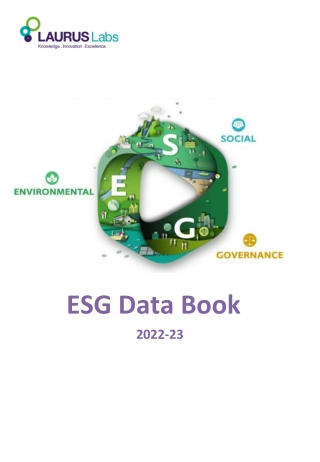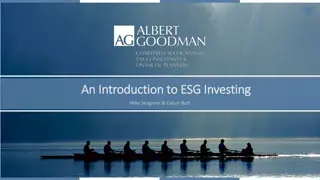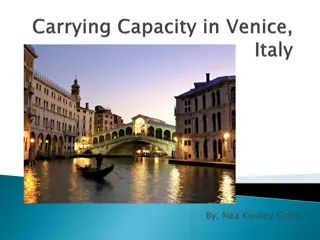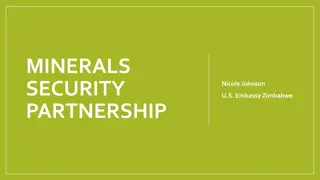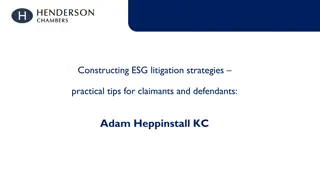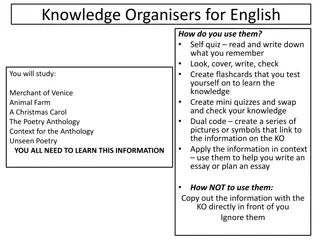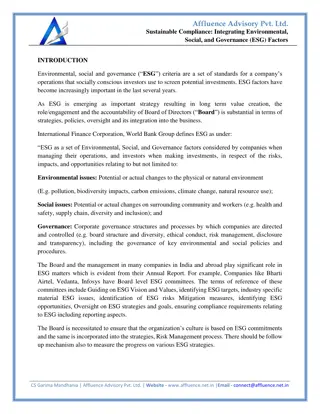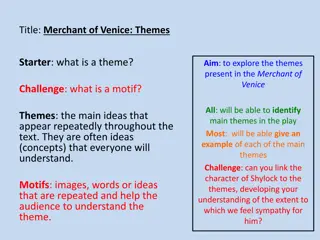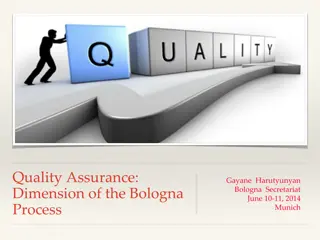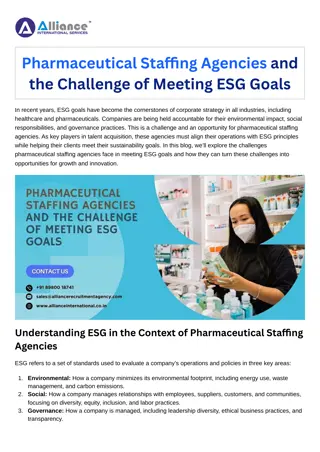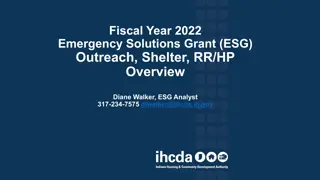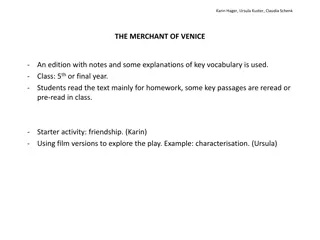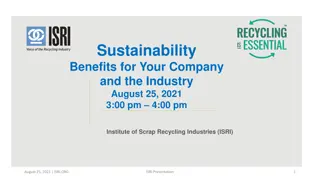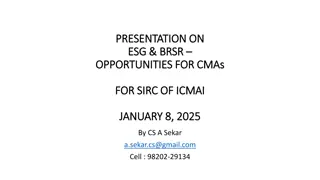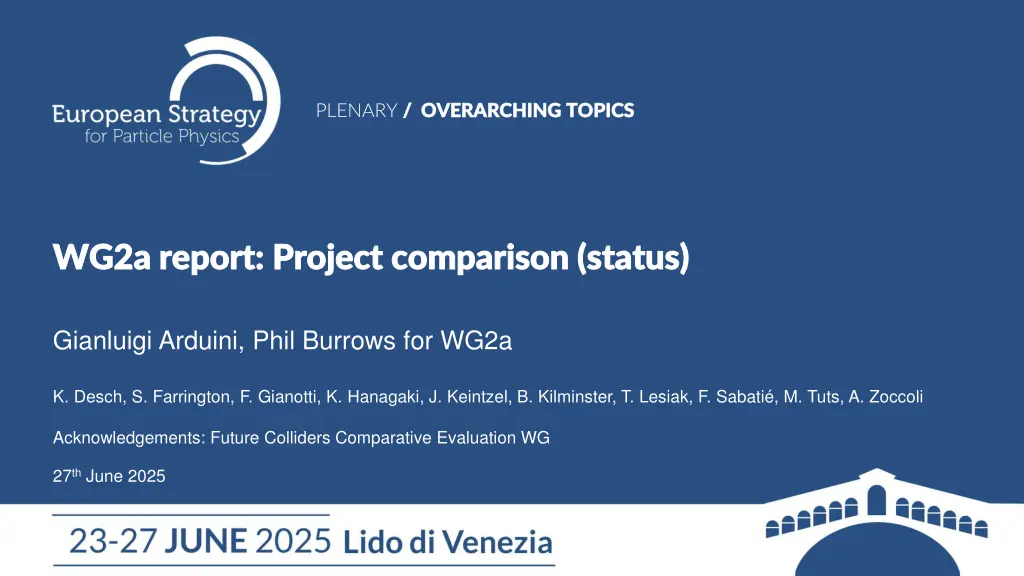
Future Colliders Comparative Evaluation Summary
"Explore the latest updates on future collider projects at CERN, including project comparisons, assessment criteria, and potential implementations. Stay informed on the advancements in particle physics research for the mid-2040s and beyond."
Download Presentation

Please find below an Image/Link to download the presentation.
The content on the website is provided AS IS for your information and personal use only. It may not be sold, licensed, or shared on other websites without obtaining consent from the author. If you encounter any issues during the download, it is possible that the publisher has removed the file from their server.
You are allowed to download the files provided on this website for personal or commercial use, subject to the condition that they are used lawfully. All files are the property of their respective owners.
The content on the website is provided AS IS for your information and personal use only. It may not be sold, licensed, or shared on other websites without obtaining consent from the author.
E N D
Presentation Transcript
PLENARY / OVERARCHING TOPICS / OVERARCHING TOPICS WG2a report: Project comparison (status) WG2a report: Project comparison (status) Gianluigi Arduini, Phil Burrows for WG2a K. Desch, S. Farrington, F. Gianotti, K. Hanagaki, J. Keintzel, B. Kilminster, T. Lesiak, F. Sabati , M. Tuts, A. Zoccoli Acknowledgements: Future Colliders Comparative Evaluation WG 27th June 2025
Outlook WG2a charge and status Summary of the report of the Future Colliders Comparative Evaluation WG Next steps G. Arduini - WG2a report: Project comparison (status) 27/06/2025 2
WG2a charge For projects to be considered for realisation as the next flagship project at CERN, several aspects need to be thoroughly evaluated and compared. Two sub-groups tasked: 2a) Project assessment Technical feasibility, required R&D Risks Timeline Costs and human resources (including estimates for the associated detectors) Environmental impact 2b) Physics potential Two WG2a meetings held, so far: Assigned reviewers for the large-scale project proposals submitted to the ESPP2026 Discussion on the report of the Future Collider Comparative Evaluation WG G. Arduini - WG2a report: Project comparison (status) 27/06/2025 3
Future Colliders Comparative Evaluation Working group established by CERN Directorate in June 2023, involving Project Leaders of main projects and other experts Membership: G. Arduini, M. Benedikt, F. Gianotti, K. Jakobs, M. Lamont, R. Losito, M.Meddahi, J. Mnich, N. Mounet, D. Schulte, F. Sonnemann, S.Stapnes, F. Zimmermann Goal: compare FCC and alternative scenarios in a consistent way, using common assumptions and methodology, in view of the ESPP Update 2026 Deliverables: Summaries of FCC-ee and alternative options for implementation at CERN Metrics for comparison Comparative evaluation of the potential options for realization at CERN Credible and consistent timelines for implementation and time to first physics Summary of options considered elsewhere in the world that could be realized within the given time frame Working Group report submitted as input to ESPP2026 on 26/5/2025 https://indico.cern.ch/event/1439855/contributions/6542430/ 4
FCC and alternatives at CERN Within the time frame of operation starting in mid-2040s CLIC 380 GeV FCC-ee LCF@CERN 250 GeV and their evolution (outside the above time frame): CLIC energy upgrades FCC-hh LCF@CERN energy upgrades Muon collider (outside the above time frame) Also included: Proposed reuse the LHC tunnel (LEP3, LHeC) International landscape (CEPC, ILC 250 GeV in Japan) G. Arduini - WG2a report: Project comparison (status) 27/06/2025 5
Methodology Key aspects analysed: main parameters and performance environmental aspects (carbon footprint) technical readiness materialcosts for accelerator and experiments construction and installation human resources for accelerator construction and installation project timeline material and personnel costs for operation only for first phase e+e- colliders starting in the mid 2040s Contributed to standardise/normalise the input provided by the projects to the ESPP2026 G. Arduini - WG2a report: Project comparison (status) 27/06/2025 6
Performance comparison Common assumptions for the operational scenarios for e+/e- colliders integrated luminosity estimate per year (summed over all IPs) electricity consumption per year, knowing the peak wall plug power and the fraction used during each operation phase, provided by the projects. G. Arduini - WG2a report: Project comparison (status) 27/06/2025 7
Performance comparison LP: low power FP: full power Comparison table for e+e- colliders starting in the mid 2040s: G. Arduini - WG2a report: Project comparison (status) 27/06/2025 8
Performance comparison Circular colliders (CC) are more efficient than Linear Colliders (LC) at energies up to 300-350 GeV. Note the improvement w.r.t. LEP/LEP2 LC can reach the O(TeV) region (no synchrotron radiation loss) CC can accommodate more experiments operating in parallel FCC-ee collision energy can be varied between 90 and 240 GeV seamlessly at unparalleled luminosity. LC baselines include polarized e- beam. For LCF e+ too. LEP3 proposal still at pre-conceptual design level: larger uncertainty on luminosity, power consumption G. Arduini - WG2a report: Project comparison (status) 27/06/2025 9
Environmental aspects Life Cycle Assessment (LCA) is an internationally standardised method to assess environmental impact Focus on Greenhouse Gas (GHG) emissions: *raw material supply, transport, manufacture, transport to work site, construction process on the work site **raw material supply, transport, manufacture Civil Engineering (modules A1 to A5*) HW components of accelerators, technical infrastructure, detectors (modules A1 to A3**) GHG emissions associated with electricity consumption Worked with LDG sustainability panel to guarantee coherence of the methodology G. Arduini - WG2a report: Project comparison (status) 27/06/2025 10
Environmental aspects Range of values: estimates based on presently known technologies and potential for realistic reduction (e.g. taking into account the roadmap established by the European Cement Association for CE) Major contributions expected from: HW components of accelerators, detectors and technical infrastructure (ongoing, limited to A1-A3). Data for FCC-ee expected in summer Civil Engineering GHG emissions related to electricity consumption are lower thanks to the low carbon intensity of the electricity produced in France (2050s) Reuse of infrastructure (e.g. CE) for future upgrades will benefit the sustainability of projects G. Arduini - WG2a report: Project comparison (status) 27/06/2025 11
Technical readiness Building on Snowmass 21 Implementation Task Force review and on the LDG accelerator R&D review held in February 2025: TRL of the accelerator components / subsystems representing the highest technical risk Improvement factor on critical components, R&D effort needed to reach it Technical readiness of CLIC, FCC-ee and LCF are comparable LCF benefitting of the RF developments for XFEL and LCLS-II IP spot size control and position stabilisation remain one of the main challenges for LCs e+ production rate for LCF is particularly demanding (even higher than ILC) TRL could provide guidance in prioritizing efforts in accelerator R&D considering the ESPP2026 recommendations G. Arduini - WG2a report: Project comparison (status) 27/06/2025 12
Construction and Installation Costs: Material and Personnel Detailed costing for CLIC, FCC-ee, LCF (the latter considering ILC cost update, 2 IPs, CERN implementation): Main tunnel accelerators, (pre-)Injectors & transfer lines, Civil Engineering, Technical infrastructures, Experiments with cost uncertainty class Have different level of uncertainty (and scrutiny): FCC-ee has generally the most accurate cost estimate: CE highest contributor but with good accuracy as the placement scenario has been fully defined. Cost has been reviewed by expert committees, CERN Council and its subordinate bodies Personnel for the construction of the accelerators ranges between 10 and 15 kFTEy. Consistent with scaling law developed by Snowmass 21 ITF G. Arduini - WG2a report: Project comparison (status) 27/06/2025 13
Project timeline Financial and personnel commitments for HL-LHC operations imply that a future collider cannot realistically start operation before mid 40s FCC feasibility study completed and detailed timeline established considering the above constraints CLIC, and particularly LCF@CERN, would require a preparation phase (with corresponding resources) to reach a level of detail comparable to the FCC FS Difficult to conduct two territorial implementation studies in parallel in the Host States CLIC/LCF: only relative timelines with respect to decision points (and considering the above constraint) G. Arduini - WG2a report: Project comparison (status) 27/06/2025 14
Project timeline As a 2nd phase after FCC-ee, FCC-hh could start operation in mid 2070s On a technically-limited timescale (assuming accelerated R&D) a stand-alone FCC-hh with 14 T Nb3Sn dipoles could start operation around mid 2050s G. Arduini - WG2a report: Project comparison (status) 27/06/2025 15
Operation: resources (annual requirements) Material: Maintenance and replacement costs: 3% of powering systems (e.g. klystrons, RF and magnet power converters) CAPEX, considering the limited lifetime of these parts; 1% of remaining accelerator HW (RF cavities/structures, magnets) CAPEX for replacements 5% of technical infrastructure (e.g. cooling, ventilation, electronics and electrical infrastructures, access and safety systems, cryogenics, computer and network infrastructure, control systems, robotics, lifts and transport system) CAPEX. It includes the cost of contractors; Electricity cost (assumed 80 /MWh) Personnel: Based on LHC experience G. Arduini - WG2a report: Project comparison (status) 27/06/2025 16
Muon Collider Muon Collider (MC) ambitions to approach 10 TeV pCM energy. MC has not yet reached a maturity level that gives sufficient confidence in its feasibility. Demonstration of 6D cooling is a necessary condition to assess feasibility and performance A variety of technological challenges are associated with the various acceleration steps The technical design of the demonstrator and its construction demand resources significantly exceeding the present level. A detailed timeline cannot be defined at present but only sketched with some decision points. G. Arduini - WG2a report: Project comparison (status) 27/06/2025 17
Re-use of the LHC tunnel LEP3: Pre-conceptual design with operation limited to 230 GeV, but not yet validated by simulation studies to confirm performance (luminosity, power consumption, ) Large SC RF system, possible need for SC magnets, and high-energy booster installed in the same tunnel of the collider demand for integration studies to assess extent of the civil engineering Prospected luminosity x IP number lower by a factor 6 to 10 as compared to FCC-ee, power consumption comparable to that of FCC-ee (at low energy). Resources for operation comparable to LHC G. Arduini - WG2a report: Project comparison (status) 27/06/2025 18
Re-use of the LHC tunnel LHeC: Detailed conceptual design developed and based on high-current high-energy ERL Civil engineering required for the ERL tunnel Requires demonstration of high-current multi-turn energy recovery PERLE @ IJCLab Technically-driven schedule for LHeC implies operation after the end of the presently planned HL-LHC programme at the earliest Yearly electricity consumption comparable to FCC-ee at low energy and expected operation resources comparable to LHC General considerations for options using the LHC tunnel: major infrastructure investments and operating costs delay of the implementation of a next-generation collider by at least one decade cannot be considered as bridge options but as alternative to other proposed colliders G. Arduini - WG2a report: Project comparison (status) 27/06/2025 19
Next steps (WG2a) Future Collider Comparative Evaluation WG report as (one of the) input Cost estimates and associated uncertainties used in the report have been mostly based on the Projects input Some of them went through international reviews but need to make sure that the level of scrutiny and the methodologies used are comparable Plan to co-opt external experts involved in the cost and schedule reviews of the large-scale projects (but not involved directly in any of the projects) to make sure that: Construction costs and their uncertainties Risks Timelines are assessed in a similar fashion across projects G. Arduini - WG2a report: Project comparison (status) 27/06/2025 20
Related submissions ID Title Contact 40The Linear Collider Facility (LCF) at CERN Jenny List 57HALHF: a hybrid, asymmetric, linear Higgs factory using plasma- and RF-based acceleration Brian Foster 78The Compact Linear e+e- Collider (CLIC) Erik Adli 97ESPPU INPUT: C3 within the "Linear Collider Vision" Emilio Nanni 140A Linear Collider Vision for the Future of Particle Physics Jenny List 152US Muon Collider Community White Paper for the European Strategy for Particle Physics Update Sergo Jindariani 154Midterm Review of the European Accelerator R&D Roadmap Mike Seidel 165A Possible Future Use of the LHC Tunnel Marco Drewes 174Phase-One LHeC Krzysztof Piotrzkowski 188LEP3: A High-Luminosity e+e Higgs & Electroweak Factory in the LHC Tunnel Tiziano Camporesi G. Arduini - WG2a report: Project comparison (status) 27/06/2025 21
Related submissions ID Title Contact 207The Muon Collider Federico Meloni 214The Large Hadron electron Collider (LHeC) as a bridge project for CERN Jorgen D'Hondt 233FCC Integrated Programme Stage 1: The FCC-ee Panagiotis Charitos 243High Field Magnet Programme European Strategy Input Bernhard Auchmann 247FCC Integrated Programme Stage 2: The FCC-hh Panagiotis Charitos G. Arduini - WG2a report: Project comparison (status) 27/06/2025 22

